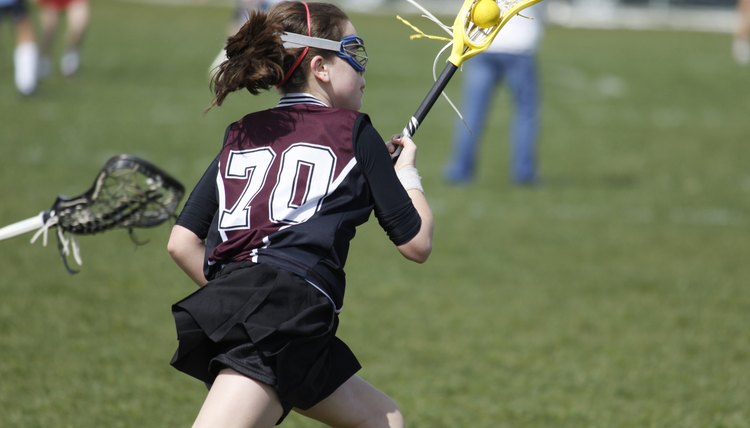Lacrosse Rules for Girls

Rules for youth girls lacrosse differ from women's and some high school lacrosse rules. Girls rule modifications depend upon age and grade division and are typically due to safety concerns as well as an emphasis on development of basic skills. Girls youth lacrosse also incorporates levels, the highest being FC, which stands for "full checking," followed by levels A, B and finally C, the lowest level. Levels incorporate specific rules that are enforced based on a team's experience.
Players
Twelve field players comprise a girls lacrosse team in high school and youth levels FC, A and B. In addition to the optional of use of a goalkeeper, level C teams field 7 girls.
Playing Field
In general, lacrosse field dimensions are comparable to a soccer field. Based on the US Lacrosse Official Rules for Girls and Women's Lacrosse, high school uses a field 110 to 140 yards in length and 60 to 70 yards in width. Youth levels FC and A girls play on a recommended field size of 120 yards by 70 yards, with level B dimensions slightly smaller. A 70 by 25 yard field constitutes level C playing area. All levels of youth girls lacrosse require the basic field markings of sidelines, end lines, a center line, 8 meter arc, goal circles (also known as the crease) and goal lines. US Lacrosse also specifies that a 12-meter fan, center circle, and restraining lines are necessary for high school and levels FC, A and B.
Game Duration
Girls lacrosse games are split into two halves, and vary in length depending upon level of play. A maximum game length of 25 minutes each half is allowed for high school, levels FC, A and B, whereas level C is permitted 20 minutes per half at most.
Equipment
Regardless of age or level of play, all girls are required to wear protective gear in the form of a mouth guard and eye mask. Goalkeepers wear a helmet, throat guard, chest protector, gloves, pelvic protection and shin and thigh padding. A regulation lacrosse stick, also called a crosse, is required for participation in girls lacrosse and is strung to create a shallow "pocket." In high school, levels FC and A, if the top of the ball is even with or above the sidewalls of the stick head when dropped into the pocket and slight pressure is applied, the crosse is legal. In levels B and C, modified pockets are permitted, where half the ball may fall below the bottom of the sidewall. Although lacrosse balls come in many colors, only yellow or bright orange are permitted for use in games.
Contact
Girls lacrosse is considered a noncontact sport, consisting of rules that dictate minimal physical contact. In high school and level FC, players are allowed to use their stick head to knock the ball from their opponent's stick head, called checking. Checking is only permitted when performed in a quick, controlled, downward motion away from the body. Checking allowed when the entire crosse is below the shoulders is considered modified checking, and is permitted in level A. No checking of any kind is permitted in levels B and C.
Playing the Game
Each game begins with a draw, where the ball is placed between the heads of two players' sticks held horizontally and positioned above the waist. On the whistle, sticks of both players are pulled up and away from each other, causing the ball to fling into the air. Another important rule involves the crease, and prohibits players from crossing the line with any body part or crosse. Only the crosse of players in high school and level FC are permitted to cross the crease when following through on a shot. Stopping and standing still on the whistle is also a basic, but important rule, and girls cannot move again until the whistle is blown. Finally, there are numerous minor and major fouls that may occur in a game, details of which can be found in the US Lacrosse Official Rules for Girls and Women's Lacrosse.
Writer Bio
Born and raised in the Pacific Northwest, Kristin Maricich grew up running, playing sports and enjoying the outdoors. She attended Western Washington University, achieving a B.S. in exercise and sport science: fitness and health specialist, and discovered a passion for lacrosse. As an ACSM HFS and member of the PCA, she currently volunteer coaches for Bellingham Girls Lacrosse, SV Flyers Lacrosse and Anacortes MS Cross-Country.
